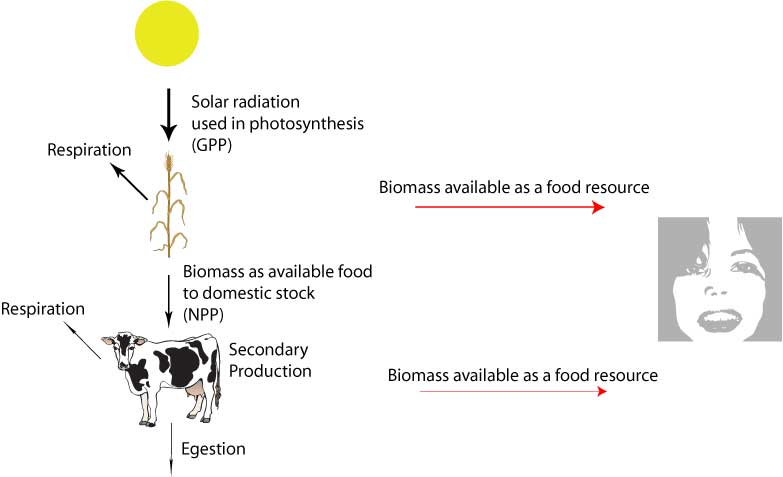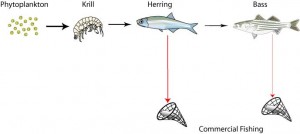3.5. 2: Efficiency of Food Production
 The food systems that humans depend on for survival follow the same paths and rules as any food chain:
The food systems that humans depend on for survival follow the same paths and rules as any food chain:
All food chains all conform to both the first and second laws of thermodynamics (review these ideas). As energy flows through a food chain the amount passed from one trophic level to the next trophic as available food decreases. The result of this is that generally the number of organisms at each subsequent trophic level decreases.
In a food system, unlike a natural food chain, the supply is not only dependent upon how many organisms there are at each proceeding trophic level but also the efficiency of energy conversion at each level. That includes not only the ability of organisms to convert energy to biomass but also minimizing losses of production in the actual system itself.
Terrestrial Agriculture
 As food chains terrestrial agricultural systems tend to be short chains with food removed at low trophic levels, either from producers directly or primary consumers. However even within these short food chains there is low efficiency on top of natural decline in available energy along a food chain. It has been estimated that only around 43% of the entire worlds cereal crop is available as food to humans. The greater proportion is either lost in the production cycle through in efficient harvesting and processing or is used as animal feed.
As food chains terrestrial agricultural systems tend to be short chains with food removed at low trophic levels, either from producers directly or primary consumers. However even within these short food chains there is low efficiency on top of natural decline in available energy along a food chain. It has been estimated that only around 43% of the entire worlds cereal crop is available as food to humans. The greater proportion is either lost in the production cycle through in efficient harvesting and processing or is used as animal feed.
Dietary change over the last 50 years has meant that more and more societies are becoming meat dependent to the extent that grazing land alone can not supply enough meat so much of the world meat production depends on supplementary feeding of cereal crops. Increasing the inefficiency of conversion of plant biomass to animal biomass inherent in terrestrial food chains
Aquatic Food Systems
In aquatic food systems the position is slightly different. Humans tend to feed much higher up the food chain than the do in the terrestrial system, trophic levels 4 and 5. This means that the food chains are much longer as so naturally the relative available energy has reduced substantially from the original input energy.
 The system is impacted upon as well by the fact that producers in aquatic systems receive less sunlight than their terrestrial equivalents in similar parts of the world. The water column itself absorbs and reflects a high proportion of incoming solar radiation before it can be fixed in photosynthesis. Thought the efficiency of energy transfer between trophic levels is usually greater in aquatic systems as less biomass is locked up in bone and skeletal materials compared to to flesh.
The system is impacted upon as well by the fact that producers in aquatic systems receive less sunlight than their terrestrial equivalents in similar parts of the world. The water column itself absorbs and reflects a high proportion of incoming solar radiation before it can be fixed in photosynthesis. Thought the efficiency of energy transfer between trophic levels is usually greater in aquatic systems as less biomass is locked up in bone and skeletal materials compared to to flesh.
The production methods used in aquatic systems themselves impact upon the efficiency. Humans are very selective in the fish species that they eat compared to the often un-selective catch methods: trawling and netting. This results in firstly over fishing and the removal of more stock than the system can replace, around half of the worlds fish catch is taken from less than 7% of the oceans, and secondly the discarding of around 30 million tonnes of “unwanted” catch each year.
